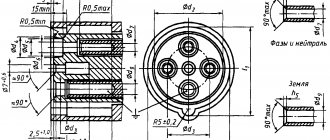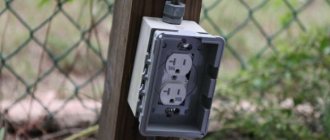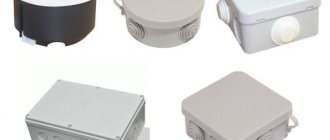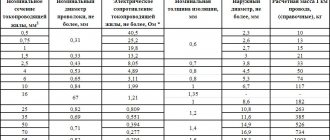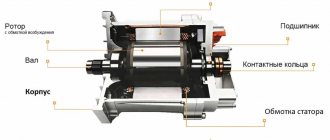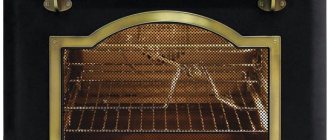A socket is an electrical connector that connects household and industrial electrical appliances. They come in two types: for hidden installation (inside walls, countertops, partitions) and for open installation, when the socket is mounted on a surface.
Household appliances are connected to an outlet using a plug or electrical plug. Different countries use different forms of plug connections. This is something to keep in mind when traveling abroad with electrical appliances: you may need an adapter.
Types of sockets
Power connections differ in shape, method of fastening and number of contacts.
The socket can have from 3 to 5 connections. To understand the difference, it is important to study the operating principle. In the CIS countries, a three-phase network with a voltage of 380V is used. A standard apartment uses 220V. This indicator can be obtained by connecting one of the three phases to the neutral wire. To connect a 380-volt industrial outlet, it is enough to combine two phases and a neutral wire. A conventional electric stove has a similar connection principle. There are several standards for power connectors:
- 2P+PE - two phases and one grounded contact are used;
- 3P+PE - 3 power cables and one grounded;
- 3P+PE+N - 3 phases, one ground and zero;
- 3P+N - three power contacts and one neutral. Socket 380V 2P+PE Socket 380 3P+PE Socket 3P+PE+N Plug 380 3P+N
Switching connections differ not only in the number of contacts, but also in the structure of the housing. There are cable structures that serve to connect portable devices. Flange switches are manufactured with a mount that can be built into the wall directly or at an angle. The last type is overhead sockets. Some cases are equipped with an additional protective cap.
Marking
The letter P indicates the power or phase wire, N stands for neutral, and the designation PE indicates the grounding cable.
The wires are also color coded. Electrical installation rules require that the phase be designated in burgundy, red or brown, and zero in blue or a light blue tint. The earth is painted in two colors - yellow and green. In addition to the voltage, the maximum permissible current is indicated on the case. An industrial 380V socket can withstand 16A, which is acceptable for a regular network. For more powerful ones, connections of 32, 63 and 125 amperes are used. To avoid overheating and fire, it is important to check the electrical current strength in advance.
The marking may also indicate the degree of protection. IP44 indicates that the outlet insulates electrically conductive areas from splashing water and dust particles. Often such cases are equipped with overhead protection.
The IP64 marking implies a completely sealed housing. Maximum protection allows connections to be made indoors or in open spaces with high humidity.
Models with additional features
With built-in RCD
An RCD protects a person from electric shock. Some sockets of built-in and portable types come immediately with a built-in RCD. When a minimum current leaks, the RCD instantly opens the contacts, preventing electric shock and protecting the electrical appliance. The cost of such models is on average 6–7 times higher than the cost of conventional single sockets.
With curtains
In such models, a special shutter is placed over the contacts, which opens only when the plug enters the socket. These curtains protect small children from electric shock. Moreover, in many models, the curtains open only when the plug enters two contacts at the same time (for example, you cannot insert a thin metal object into only one contact).
- Exploitation
What are smart plug manufacturers silent about?
With lid
Devices with a hinged lid are used in rooms with high humidity, for example, in the bathroom, repair boxes and rooms with pumping stations. At the same time, the cover protects not only from moisture, but also from dust and debris, so you can use the outlet in heavily polluted areas, for example, in a flour mill.
With timer
A timer device allows you to set a time period during which the outlet will operate and then stop supplying power to a specific electrical appliance. This type of outlet is especially convenient when you have a heater without a timer, but you want it to turn off at a certain moment. Although in some cases it is advisable to replace the heating with a unit with a timer, in some cases it is still economically advantageous to use just such an outlet.
With electricity meter
Such models are equipped with an electricity meter, which allows you to keep track of consumption for a specific electrical appliance. In fact, with the help of such an outlet you can individually calculate the flow rate for each device and understand which one is more profitable to use (for example, in the case of heaters).
With USB connectors
These are modern sockets with USB outputs that allow you to quickly charge your phone or tablet. This way, the extra socket connector is not occupied, and you can also charge an electronic device if you have lost or cannot find the plug for it.
With Wi-Fi module
Models with a Wi-Fi module allow you to control the outlet remotely from a smartphone. This can be convenient when you need to turn on/off a device that does not have its own shutdown timer from the network remotely. Many of these outlets have a connection to the smart home system.
Tips for home electricians:
- Copper or Aluminum: Which is Best for Wiring?
- How to correctly take electricity meter readings?
Socket with grounding 220 V for 16 and 32 A - technical characteristics
If we take the European part of the continent and all of Russia, then the standard voltage (U) in the network is from 220 to 240 V. Conventional sockets are designed for a voltage of 220 V with a load of no more than 3.5 kW.
The operation of such sockets is limited to household appliances of low power and are designed for a current (I) of 16A.
If we take more powerful electrical appliances (electric stoves, ovens and other electrical appliances), then other sockets are provided for them with a maximum current (I) of 32 A and a maximum permissible power of 7 kW.
The AC frequency for Europeans and Russia is 50 Hz, which means that all electrical equipment is designed for this frequency.
The degree of protection from dust (objects) and moisture varies among sockets. Some have no protection at all, and some have IP20, IP44, IP54 and others. The higher the IP, the higher the protection. For example, IP54 - “5” protects from all kinds of objects completely and partially from dust, “4” protects from splashing water.
The following brands of sockets have IP54: EL-BI EVA, ABB EVA, VIKO, EKF, DelUMO and others. Such sockets are installed in damp areas, for example, in bathrooms.
Basically, in our time, cases (not the lid) are made of ceramics and non-flammable plastic. Of course, ceramics have an advantage, because polymers are always inferior to ceramics in terms of durability and heating.
Copper or brass contacts are screwed onto the body using screws. Some sockets use springs to ensure better contact with the plug.
There are modifications of sockets in which the phase and zero holes are closed with curtains inside under the cover. Such sockets are good to use in places where there are children.
If you look at the PUE, then according to the requirement, a three-wire system (phase, neutral and ground) with a single-phase connection is installed everywhere at all facilities. Grounding is an additional safety measure against electric shock to a person.
All equipment, instruments and tools are equipped with special plugs (with grounding), where the third wire is connected to the housing, which means that the housing is grounded and does not pose a threat to a person coming under voltage.
When the plug is combined with the socket, phase, neutral and ground contact occur. And first grounding, then phase and zero.
Materials
Three-phase socket: features and connection
The block used to be made of ceramic, but now it is more often made of thermoplastic or special polycarbonate. The plastic base is less fragile and cheaper to manufacture. The material has high performance parameters, but is inferior in quality to ceramics, deforming from heat and having a lower breakdown voltage.
Contacts are made of bronze, brass or copper plates. The alloy must be resilient to ensure a secure connection with the pins of the plug.
Receptacle with ground contact for exposed wiring
A socket for open (external) wiring, it is also called “overhead”. It is mounted directly on top of the wall. This type of installation is quick and simple, but not entirely aesthetically pleasing in everyday life (apartment, cottage, office and other similar places).
This type of installation is relevant for industrial premises, outside buildings, in outbuildings and other typical places. Electrical wiring to overhead sockets is laid in a special corrugation or cable tray.
Purely aesthetically, plug sockets for hidden wiring, after mounting them on the wall, look much more impressive than overhead ones, and the wiring is not visible.
From the point of view of electrical and fire safety, this method of installing sockets and laying wires is the most optimal.
If we compare the installation of the open type and the hidden type, then the hidden type is more labor-intensive, since the time and physical costs increase.
Basically, for installation in residential premises, sockets with a protection level of IP44 are used, but of course others are also possible.
Double pole sockets
These, with a round shape of plug contacts, are used in everyday life and offices for a voltage of 220 V in Europe and Russia. (In the USA and Japan 115 V with flat contacts). They can be with or without grounding. Grounded sockets are now replacing those still in use without grounding with a “thin” plug.
The Euro socket becomes the de facto standard and has thicker pins that are incompatible with older sockets. Previously, the only place for their attachment was walls, then, for the convenience of consumers, they began to be built into equipment and furniture. There are now different types on the market to suit all occasions.
Grounded outlets are also considered double-pole because the ground does not provide a path for operating current but serves only for protection purposes. They require a ground bus, although in many places they work without it. For example, in places where electrical network equipment has been preserved since the fifties of the last century.
Built-in sockets are used for convenience and space saving. For example, built-in sockets for the kitchen can be located in rotating and retractable housings built into the kitchen furniture. This makes it easier to work with electrical appliances, since the convenient location of the sockets significantly reduces the risk of the consumer getting caught on the cord and knocking something over or falling.
If they are not needed, they can be removed by pressing the housing or turning it. The sockets are hidden and the furniture looks more attractive. Pull-out sockets for countertops are usually designed as a triple socket - in the kitchen they often connect two appliances at the same time and a reserve would not hurt, so a triple socket is very optimal in this design.
In addition to such new products as retractable sockets for the kitchen, sockets with a timer are appearing on sale. Their purpose is to help save energy or create the impression that there are people in the house (to protect against burglars). Sockets with a timer are produced in several modifications. The simplest and most inexpensive models are combined with a mechanical countdown timer.
More advanced sockets with a timer, instead of mechanics, use a controller with a display and buttons for programming it. They allow you to create a schedule from many points or cycle a sequence of switching off and turning on. Naturally, they cost more.
All receptacles with a timer must provide at least 16 amps of current without overheating the contacts during continuous operation. The fact is that sockets with a timer are switched by electromagnetic relays; semiconductor switches do not provide electrical safety in terms of leakage currents (if the socket is disconnected, you can get an electrical injury).
Triple sockets in combination with a timer are rarely used, since each output must be controlled separately (except for very simple models with a mechanical timer), and this complicates the design. Manufacturers understand how easy it is to mislead consumers and do everything to eliminate any misunderstandings.
Child-resistant sockets are also available. Small children can become energized due to their curiosity, so on such products they use a mechanical blocking of access to its sockets, designed so that only adults or children of a sufficiently responsible age can overcome it.
Ceiling sockets are used to connect a chandelier; this is a completely separate type of socket. Also, stationary sockets built into the floor are not used - this is unacceptable in terms of electrical and fire safety and they will easily become littered with dust.
In addition to 220 V network sockets, sockets for other purposes appear in the same sizes, among which TV sockets for connecting televisions to antennas or cable networks have begun to occupy a prominent place. They are divided into two groups: there are end (terminal) sockets and pass-through sockets. The feed-through socket must provide a matched characteristic impedance for the subsequent pass-through or termination socket.
When planning the location of subscriber devices in rooms (TVs or computers), you need to take into account what is called the network topology. Usually for private consumers this is a very simple single-line chain of two or three through sockets and one terminal socket, sometimes there are branches. It is important to remember that a pass-through TV socket can be not only a pass-through, but also a tee, this helps optimize the length of the cables.
For outdoor use, outdoor sockets are used. Outdoor sockets are made in a protected design, from IP44 and higher. The double external street socket is the most common; hidden (mounted flush with the surface) street sockets are not used, they don’t even have a designation in GOST 21.614–88.
An outdoor outlet in this design is too vulnerable to moisture and unsafe. A double external socket often helps to get rid of unnecessary extension cords, which can be unsafe in wet soil and grass.
Basic principles of connection
Connecting a three-phase socket consists of connecting 4 (without a grounding conductor) or 5 conductors, three of which will be phase, the fourth will be neutral, and the fifth (if any) will be ground. When purchasing an outlet, you need to know whether the plug on the appliance will fit into it. If not, then it’s better to buy a plug (you can change it on the equipment).
Before starting work with a voltage indicator, it is necessary to determine where the phases, neutral and ground are located on the supply cable. It is important not to mix it up, since connecting a phase to the zero or ground terminal will result in equipment breakdown and electric shock to a person. Then turn off the supply voltage and check that it is missing using a tester.
After all the work has been carried out, you should turn on the power supply, make sure that there is no phase on the case, measure the voltage between the phases - it should be 380 V. The socket is connected correctly if all conditions are met.
Types of three-phase connectors
There are 380 volt sockets: four-pin - PC 32 and five-pin - 3P+PE+N. They differ in the connection diagram and the number of plug sockets. The circuit diagram of a 380 volt 4-pin socket is the same as that of a five-pin socket, the only thing is that the grounding is not connected to the connector, but directly to the body of the electrical equipment, and therefore it is used only for stationary equipment. Five-pin - used for moving installations, and a plug connected to a flexible copper wire is connected to them.
There are also imported sockets, but they are more expensive than domestic ones. Their use is determined by design requirements or the presence of a corresponding plug in the device.
Another important point of difference between sockets is the specific current for which they are designed. It is necessary that this value exceeds the maximum current of the connected electrical equipment.
Also, 32a contact sockets are divided according to the installation method into internal and external. Internal versions are in great demand because they are easy to use, but their installation requires additional labor, namely: drilling a hole in the wall for the socket box, securing it with alabaster and mounting the socket in the installation box.
Outdated connection method
In the past, it was possible to connect the phase and neutral wires to the outlet terminals in any order, and this did not adversely affect the performance of electrical equipment manufactured using the TN-C system. The only thing was that it made it inconvenient for repairmen when troubleshooting. Today, electrical equipment is produced that is sensitive to incorrect connection of phases and zero, so it is important not to make a mistake when connecting, otherwise a malfunction and emergency situation may occur.
In Soviet times, four-wire wiring was used, including three phases and zero. Three-phase stationary type sockets were connected, which were marked with phase and zero symbols (zero was signed with a grounding symbol) on the forward and reverse sides. The same markings were on the fork. These four-pin plugs and sockets are still used today, connected as TN-C, grounded only and using a five-conductor power cable. Where three wires will be - three phases, the fourth - zero, and the fifth - grounding.
Types of socket plug connections
Electrical outlets vary in type of plug connection. Different countries have adopted their own standards for sockets and plugs for electrical appliances.
In Russia and the CIS countries, sockets of type C and F (European Union standard) are used for household appliances. Type A and B (earthed) are used in the USA, and Type G in the UK. Type D sockets are installed in Arab and Middle Eastern countries, but this option can sometimes be found in Britain. In Israel, type H sockets are used. Chinese home appliances for the domestic market are designed for type I sockets.
Tip: When going abroad, do not forget to take an adapter for your electronic gadgets.
Connection diagrams
The connection plan differs for different types of 380 V sockets. The characteristics and connections also vary. The diagram of a five-pin socket has already been discussed above; now it is proposed to take a closer look at connecting 4 pins.
The types of old types of sockets can be quite successfully used in a modern five-wire wiring system using TN-S grounding. In this scheme, protection against leakage current is provided by the PE ground wire, which is connected to the central PE ground busbar. This conductor is connected directly to the electrically conductive part of the equipment body, and not to the grounding contact of the outlet, which is missing in this case.
Naturally, a three-phase device must be stationary so as not to reconnect the ground.
380V sockets
Before we talk about ways to connect 380V sockets, let's look at their modifications and features. As an example, we will have an IEK 380 V socket, the model range of which allows us to consider all possible connection options
First, let's look at the types of 380V sockets. Indeed, depending on the modification, their connection method also changes. Therefore, let's determine what types of sockets exist.
A variety of 380V socket models
- Before proceeding directly to the consideration of sockets, let's remember the school physics course. As you all should remember, our country uses a three-phase 380V network. Three-phase - this means that we have three phase wires.
Differences between phase and line voltages
- The voltage between each of these wires and ground is 220V. This is called phase voltage. In most cases, this is what is supplied to our houses and apartments. For this, one of the three phase wires and a neutral wire are used (see Grounding and neutral wire: how to distinguish).
Phase and line voltage
- But the voltage between the phase wires is 380V. And this voltage is called linear. In this case, a voltage of 380V is obtained when measured between any two phase wires. That is, we can get a 380V network using not all three, but only two phase wires.
- This two-phase connection is often used in various electrical installations. At home, you can find this type of connection in electric stoves, as well as in some other electrical installations.
- According to the PUE standards, a three-phase electrical network up to 1000V can be four or five wires. That is, to the three phase conductors we will add one or two more. What kind of conductors are these?
Number of wires for three-phase and single-phase networks
- First of all, this is a neutral conductor, which is necessary if the electrical installation has circuits operating at a voltage of 220V. Usually this is starting equipment or protection circuits. Although it is quite possible that in your electrical installation this is the operating voltage. The neutral conductor according to clause 1.1.29 of the PUE is designated by the symbol “N”.
- In addition, for almost any 380V network, the instructions provide for a protective grounding conductor. It is necessary to protect a person from touch stress. That is, if the insulation in your device leaks and it shorts to the housing, the grounding conductor will create a safe potential on the housing. Such a conductor is designated as “PE”.
| Based on the above, there are several types of 380V outlets. The first type is a 2P+PE socket. It has two phase or as they are also called power contacts, as well as one grounding contact. | |
| The next possible option is a 3P+PE socket. It has three power contacts and one grounding contact. | |
| Another option offered on the market is the 3P+N socket and plug. It is no different from a 3P+PE socket and is actually this socket. This is where the sellers make a mistake, positioning it incorrectly. | |
| The last possible option is a 380 V electrical socket 3P+PE+N. This type of socket has three contacts for connecting three phase conductors, one contact for connecting a grounding conductor and one contact for connecting a neutral wire. |
Considering the types of sockets, it should be noted that they differ from the usual 220V sockets not only visually. There are a lot of differences here that are also worth paying attention to.
So:
- First of all, this is blocking the plug and socket from an asymmetrical connection. The fact is that for 380V sockets it is very important that the phase contact of the plug is connected to the phase contact of the socket. The same applies to neutral and grounding conductors. Otherwise, a short circuit may occur.
- In order to eliminate the possibility of such an asymmetrical connection, manufacturers place the contacts at a special angle, of different sizes and with a special guide. This virtually eliminates the possibility of incorrect activation.
The photo shows the norms for the location of contacts and locking devices
- Another feature of such sockets is the presence of a lock from turning on under load. The fact is that the loads of 25, 63, 125A for which these sockets are designed are quite significant. And the socket does not have arc-extinguishing elements to turn off such currents. As a result of trying to remove a plug and socket under load, you can not only burn them completely, but also get very dangerous electrical and thermal burns.
380V socket with electrical interlock
Therefore, manufacturers equip sockets with mechanical or electrical interlocking. Since electrical interlocking is quite complicated in design and connection, and the price of such an outlet will be an order of magnitude higher, mechanical interlocking is preferably used.
Mechanical locking also comes in several types. But the market often offers sockets with simple manual locking.
It blocks the plug and socket from accidental loss of contact, and also requires a certain action from the person before removing the plug. This action is supposed to make the person remember to turn off electrical equipment before unplugging it.
Having understood the main types and features, you can consider connecting a 380 V outlet. We will do this separately for each type.
Connecting 2P+PE and 3P+PE sockets
Let's start with the simplest connection of a 2P+PE socket. As the name suggests, for this we need two phase wires and one ground wire.
- Based on this, before making the connection, we need to determine the wire data. To do this, we need to decide on the distribution board in which the connection will be made, as well as on the circuit breaker of the appropriate power.
Note! To connect a 2P+PE socket we need a two-pole circuit breaker. In some cases, it is possible to use a three-pole machine, in which we will only use two poles. The rated voltage and rated current of this machine must correspond to the rated values of the socket.
- If you will make all the connections yourself, then first of all we run a cable or wire from the distribution board to the outlet. In this case, a three-core cable of the appropriate cross-section will suit us.
- Now we make the connection in the distribution board. First we connect the protective ground wire. To comply with PUE standards and facilitate the connection of the socket, it is advisable to use a yellow-green conductor. We connect it to the PE bus, which should go in the distribution board in addition to any automatic machines.
Connecting PE and N buses in the switchboard
- After this, we connect the phase conductors. They are connected to the terminals of the machine. Before connecting, make sure the machine is turned off.
- Now we connect directly to the outlet. First of all, we again connect the protective ground wire. Above, we have already decided on its labeling.
Note! If you do not know which contact to connect the protective grounding wire to, you can always determine this visually. According to the PUE standards, the design of any socket must ensure that the grounding contact is closed first. Because of this, the plugs have a longer blade to create a grounding circuit.
- After this, we connect the phase wires to the two remaining contacts. There may be two connection options: screw or clamp. Both options are quite reliable, but I personally prefer screw contacts.
3P+PE socket connection diagram
- The circuit diagram of a 380V socket of the 3P+PE type is almost identical to the connection of a 2P+PE socket. The only difference is the number of phase conductors, of which in this case we have three. In addition, for such a connection we only need a three-pole circuit breaker and a four-wire cable. Otherwise the connection is completely identical.
Connecting a 3P+PE+N socket
We will need the largest number of wires to connect a 3P+PE+N socket. But this does not mean at all that this type of connection is much more complicated.
Connection diagram for 3P+PE+N socket
As in the first two cases, it begins with transferring a cable or wire from the outlet to the distribution board. The cable must be five-core.
So:
- First of all, we connect the grounding conductor to the corresponding bus in the distribution board.
- After this we connect the neutral wire. PUE standards require the use of a blue cable core for this. The neutral bus in the distribution board is also usually marked in blue or with a corresponding letter marking.
- We connect the phase wires last. To do this, we place them on the output of a three-pole machine. Before connecting, make sure the machine is turned off.
Classification
Sockets are made with different types of subsequent installation and number of connectors.
Internal and external
Internal recessed type sockets are used more often. They are more convenient to use because they are mounted in the wall and connected to hidden wiring. For them, a special niche is made in the concrete into which the mounting box is attached. Models are equipped with internal steel paws with teeth. They move apart using a screw connection and, due to friction against the side walls, hold the structure in a hidden mounting box. The device does not provide a permanent, strong connection and has to be tightened from time to time. More reliable is the method of screw fastening directly to the box, which is firmly fixed with gypsum mortar. The cable is brought to the socket through a channel inside the wall, its ends are connected to special clamps. It is important to firmly attach the ends of the wires to the contacts, otherwise sparking and burnout of the connection will occur in this place.
Location of recessed sockets
As can be seen from the figure, internal sockets with hidden wiring are easy to connect and look good. Their bodies are only covers with sockets, and the main part is placed inside the wall.
External sockets (surface type) are used for wiring that is not hidden under plaster, but placed in pipes or cable ducts.
What does an overhead socket look like?
This placement of the cable is done when it is impossible to lay hidden wiring to provide access, as well as in auxiliary or production premises. The internal structure is no different from a recessed type socket. The base and body are mounted on the wall through a socket made of non-conductive material. External sockets can be equipped with additional lighting, a timer and a push-button plug ejector.
By number of poles
Sockets can have from one to four poles. In Russia, two-pole, with a grounding contact, is more common. Multi-pole sockets are usually used in three-phase networks when connecting machines, pumps, electric boilers, etc.
Three- and four-pole sockets
The shape of contact with the pins of the plug can be round (classic version), flat or combined. Flat pins are often used on foreign-made forks. The figure above shows a two-pole (a) and three-pole (b) socket with a grounding contact complete with plugs. They are designed for a current of 25-32 A and are mostly used to connect electric stoves, washing machines, machine tools, pumps and other powerful equipment.
It is prohibited to use a neutral wire instead of a ground wire. If phase and zero change places during repair work, the phase potential may appear on the body of the electrical appliance.
Advice from experienced electricians
Classification of degrees of protection
Three-phase sockets must be carefully selected and installed. It is necessary to be guided by several basic points. The first is current strength. There are three types - 16, 32 and 64 A, respectively. The required one is selected based on the planned load.
The protection class shows the degree of resistance of the outlet to humidity, dust, and dirt. IP mark and numbers - the higher the value, the better, especially if there is moisture in the premises: bathrooms, bathhouses, etc.
An additional point is the installation method. The socket can be mounted on the wall (overhead) or a separate socket can be made (hidden). However, the type of device differs significantly.
The number of connecting contacts - four, five, seven - depends on the wiring diagram used and the required level of network reliability
Particular attention is paid to the method of fastening - screwless ones may turn out to be of poor quality, disposable
You can install and connect a three-phase reinforced socket yourself if you familiarize yourself with the basic requirements and follow safety rules when working with electricity. To make it easier to replace the power point, it is better to choose a classic model, otherwise you will have to change each one in the room or purchase additional ones in advance. The design and location of incoming groups are individual and do not affect performance.
Safety regulations
When installing and operating power outlets, the following safety precautions must be observed:
- The connection must be made with the line at the input package completely de-energized.
- Use only high-quality materials from trusted manufacturers in your work.
- Place nests no closer than 50 cm from kitchen sinks, water, gas and sewer pipes.
- Be careful when connecting wires, check that the connection is correct before applying voltage.
Compliance with these rules will allow for proper installation; using the stove will not cause problems for many years.
Three-phase network device
Each 380V socket consists of at least 4 contacts: three phase wires and one neutral wire are suitable for it. The voltage between phases is 380 volts. A voltage of 220V is obtained if you measure it between any of the phases and zero. Each of the phases is capable of carrying a load of no less than three and a half thousand watts, and when connected together they can provide power to a load of up to ten and a half kilowatts or more, depending on need.
In each of the three phases, compared to the previous one, there is a movement of the sinusoid by an amount equal to one third of the period, which in total gives a total sinusoid voltage of 380 volts. How to use a multimeter to measure voltage, be sure to read the article on our website.
Such indicators are necessary, first of all, to supply power to electric motors, which can be used in a wide variety of areas. Obvious examples of such applications: winches that raise and lower elevator cars; lathes and other machines; ventilation systems and much more.
Important to know: a 3-phase socket can, if necessary, be used to produce a single-phase current of 220 volts. To do this, you need to connect two contacts on the plug connected to it: zero and any of the three phases. This way the required voltage will be obtained.
Socket device
The design includes a base (block) with a protective housing and metal contacts placed inside. They provide connections to the pins and also hold them together with the plug and wire. Metal platforms are attached to the base, to which the supply wires are screwed and where the contacts are located. In addition, there are also grounding contacts made in the form of two spring-loaded metal strips.
According to the requirements of the PUE, the apartment needs a separate grounding circuit. On the plug of the connected device there is a third ground contact connected to the housing. It is spring-loaded and additionally keeps the plug from falling out of the socket. All elements are connected using screws.
Plug socket device disassembled
The figure shows the socket with protective curtains covering the contacts. When the plug is inserted into the housing holes, they move away, providing access to the current-carrying parts. To make the curtains wear out less, they are reinforced with metal rings or strips. There are designs in which the curtains are moved back manually by turning the plate covering the socket.
Areas of use
The main areas of application for three-phase connectors remain industrial and construction sites. Almost all welding machines, mixers, industrial hammer drills, pumps and pumps used in large facilities have an operating voltage of 380 volts.
One 3-phase socket, if we are talking about the power version, is capable of providing up to 63 amperes of load. And of course it cannot be compared with a regular 220 volt network. And if it is necessary to warm up a concrete screed, 380 volts has no alternative.
However, in everyday life this tension is applied no less, especially when it comes to a private home. The motor on the entrance gate, pump, boiler, electric stove - all of them can be designed for a 380 volt network. That is why they are trying to extend a three-phase network to every home. How to install an introductory board, read the article on our website. Whether to use a 380 volt network or not depends on each specific case. But there must be one. And if there is a three-phase network, there must be connectors for it.
Sources
- https://StrojDvor.ru/elektrosnabzhenie/kak-podklyuchit-rozetku-na-380-volt-vidy-rozetok-i-osobennosti-montazha/
- https://electromc.ru/rozetka-shtepselnaya-s-zazemlyayushhim-kontaktom/
- https://FB.ru/article/367047/rozetka-volt-vidyi-harakteristiki-shema-i-podklyuchenie
- https://MasterServisNsk.ru/elektronika/kak-podklyuchit-rozetku-na-380.html
- https://istra-gaz.ru/raschety/rozetka-380-volt-podklyuchenie-markirovka-konstruktsiya.html
- https://electry.ru/rozetki/trehfaznaya-rozetka.html
